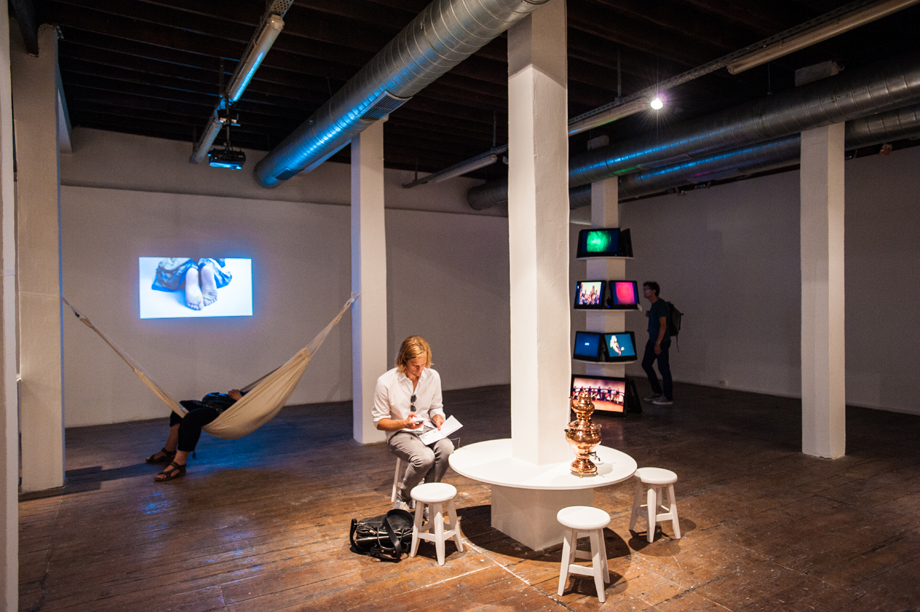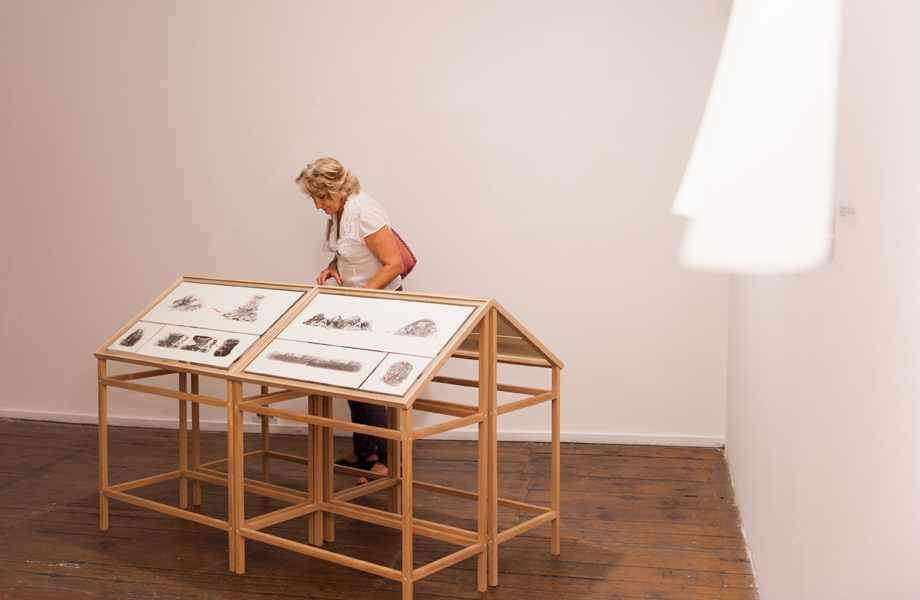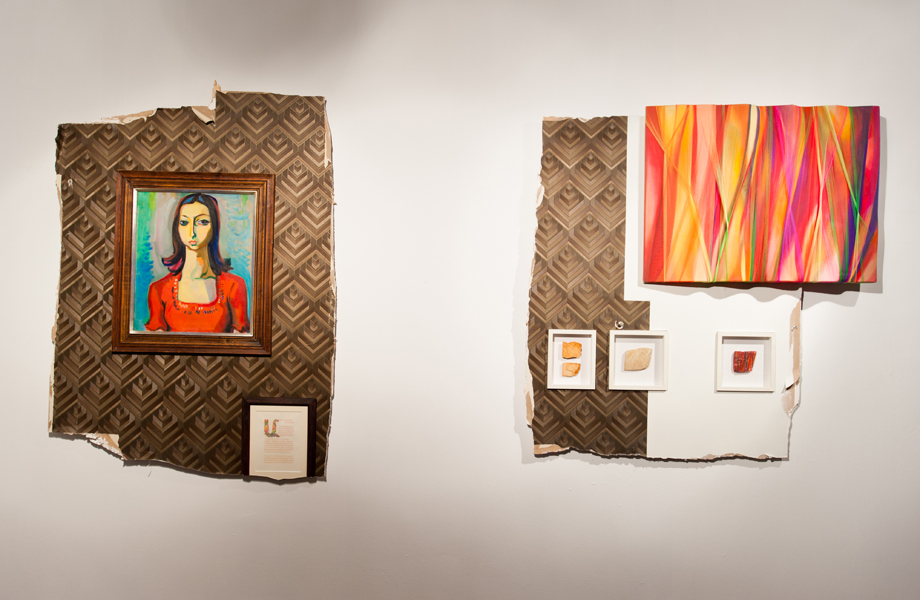Grandchildren: New Geographies of Belonging, DEPO-Istanbul, opened 3 September 2015.
Anniversaries are pretexts for remembering decisive moments in history, for interpreting them with the help of added data and research material, and filling gaps in existing accounts about them. Retrospection is employed here to elaborate further on the context of these moments and also to establish links between them and the present. The exhibitions held for commemorating the one hundredth anniversary of the Armenian Genocide had to assume the task of visualizing and presenting what happened—against the backlash of difficulties in retrieving documentary material from the distant past and against the official policies of veiling and denial in Turkey. The fact that the traces of Armenian culture on Anatolian soil have been subjected to a continuous erasure over the past hundred years expands the time span that this retrospection must scan through. Among the activities that have been organized in Turkey, there has been a propensity towards photographic exhibitions that are set to trace the remnants of Armenian history, mostly through the lens of the grandchildren of genocide survivors, coming from different parts of the globe to Turkey, searching for links that would tie them more profoundly to their ancestors and to the homeland they had been snatched off.
Grandchildren: New Geographies of Belonging, an exhibition hosted by DEPO Istanbul, differs slightly from this retrospective approach. Without neglecting the immense traumatic emptiness opened by the Genocide, the unhealed suffering and the call for justice, the exhibition foregrounds a hopeful sense of opening a gate for the future. Its positive tone is reinforced by the rich range of cultural backgrounds of the participating artists, and also by the fact that the thematic framework is not constricted by preset motifs and concepts. The fact that the project has been the outcome of a long process of interaction and discussion provides depth and focused persistence, helping to transcend the limitations of an anniversary event. The process was initiated as a series of meetings under the title underconstruction in 2004 and evolved into an exhibition that was held in the framework of 52. Venice Biennial (2007): Talking About Identities in the Armenian Transnation. The chain of events and exhibitions, with Grandchildren as the last component in the chain, has been enabled by collective work with gradually changing teams, but the contribution of Silvina Der-Meguerditchian as an artist and curator has been central. As the grandchild of a family that escaped the Genocide and settled in Argentina, the artist had plenty of occasions for reflecting upon her family`s link to Anatolia after she moved to Berlin, a city that provided contact with people from Anatolia. Her interest in collective work resulted also in her participation in Houshamadyan, an online reconstruction of Ottoman Armenian town and village life. Through invitations to exhibitions that were related either to Istanbul or Turkey, Der-Meguerditchian established links with Istanbul, opened up two solo exhibitions in the city, and took part in various workshops and events. Her experiences and networks have become the infrastructure of the Grandchildren exhibition.
Der-Meguerditchian`s skill at establishing warm personal links with people and transforming the energy of these interactions into communal activities has a structural echo in the conjunctive approach of some of her artworks: she stitches separate portraits, photographs, words to each other through materials such as threads, ropes, and yarns and produces patterns of form and signification. The Grandchildren exhibition displays this conjunctive character as well: contributions from individual artists are tied to each other through connecting devices. The artworks that are installed around the structural columns of the exhibition space of DEPO are bridged with auxiliary elements such as hammocks, a tea spot, and a reading desk—things that have relaxing effects on the audience. These curatorial interventions in setting give clues about one the main motifs of the project: separate voices, words, and images, which belong to different geographies and languages inhabiting Armenian culture, put aside distances and construct a pluralistic togetherness.
The exhibition begins with a mural painting at one the facades of DEPO, encircling the main gate of the building. Maria Bedoian`s composition summarizes the spirit of the Grandchildren project: a semi-organic, semi-architectural being with deep and partly truncated roots succeeds in stretching to the sky and produces divergent, exotic fruits on its upper branches. This hybridity between the tree and the Babylon Tower is surely reminiscent of the story of Armenian culture being deeply rooted in history and extending towards the present. Der-Meguerditchian’s first piece in the show, which welcomes the audience at the foot of the stairs, has a similarly an optimist and affirmative tone. In the video, we see one of the big names of professional wrestling in Argentina from the 1970`s, Martin Karadagian, whose reputation allowed Armenians living in Latin America to distance themselves from the haunting aspects of their past persecution and to identify with the figure of a hero, with a winner. In the film, Karadagian fights against a mummified person who is accompanied by his child who is similarly bandaged as a mummy. It looks as if they are somehow haunting ghosts coming from the past, hinting at a lack of resolution. At the end of the fight, though, Karadagian manages to cope with this trouble: he, the mummy rival, and his mummified child are all declared the winners.
 [Installation view of Der-Meguerditchian`s multi-channel video work.]
[Installation view of Der-Meguerditchian`s multi-channel video work.]
The multi-channel video installation by Der-Meguerditchian that encircles one of the pillars of the first floor shows young people performing figures from Armenian folk dancing. We are informed that they are from different cities of the world that are thousands of miles away from the homeland where these dances were originated. The dancers will perhaps never be able to see this lost homeland, but they took up the cultural codes on their bodies and weave a performative identity that they will hand down to coming generations. In another work that encircles another pillar, Scout Tufankjian brings together framed photographs that depict scenes from the everyday life of Armenian communities living all around the world, concentrating particularly on places and occasions in which identity is being constructed, such as the privacy of family, religious gatherings, schools, and coffee houses.
There are a couple of works that have a distanced approach towards the process of identification and a cautious attitude towards belonging. In his double-screen video installation, Arman Tadevosyan looks at both sides of the Armenian-Turkish national border. One screen shows children on the streets of the city of Kars, reciting the Turkish national anthem; the other displays the artist himself as a child, chanting a historical Armenian resistance song at a school gathering. In both cases, the naivety and cheerfulness of the kids contradicts distinctly with the nationalistic and aggressive tone of the lyrics. A sculptural installation of Mikayel Ohanjanyan takes its inspiration from a conversation he had with a Turkish friend who thinks that the Genocide is a complete fabrication by the Armenian Diaspora. Without expressing any judgment on the subject, Ohanjanyan seeks to visualize the tension between two completely opposite narratives. Threads stretched between two identical, cubic objects, whose stability and rigor are proved by their metallic color and purely geometrical shapes, are holding a soft, compressed texture hanging in the middle. The delicacy and fragility of the balance in this complicated constellation leaves an unsettling effect on the audience. A video piece by Achot Achot displays the soles of a person lying down. In a ritualistic slowness and glamorous colorism, the feet are covered with spilling honey and finally with white feathers. The nakedness of the feet and the lying posture of the body hint at a traumatic experience, but on the other hand the soothing stream of honey and the whiteness that comes later to cover the skin opens up the prospect of healing.
 [Partial installation view of Grandchildren: New Geographies of Belonging. (2015)]
[Partial installation view of Grandchildren: New Geographies of Belonging. (2015)]
In the performance of Talin Büyükkürkciyan Demirci we see three people, who don`t know each other, entering an abstract space and trying to accommodate themselves to this new environment. In time, they play with objects they have brought with them, try to construct things, and ruin the other’s constructions. The sentence “I was here,” which is inscribed in different languages on the wall, and the fable that accompanies the performance underlines the absurdity in human beings` claims, personally or collectively, about the possession of a designated piece of territory. Another work by Maria Bedoian displays shell-like ceramic objects on an easel, but when we come closer we realize that they are not mussels, oysters, or any other crustacean, but completely imagined, unidentifiable, artistic objects. The disconnect between the shape and the implicated definition underlines the slippery character of identity itself.
Besides these works that rely on affirmation of life and survival or on reserved reflection on representational politics, Grandchildren gives place to artworks that are permeated with grief and sorrow. Ani Setyan`s installation exhibits a wooden walking stick standing under three spotlights; in the accompanying soundtrack we hear the continuous pattern of legs shuffling and the hit of a stick. The stick actually belongs to the artist`s grandmother, and whenever the family visits her and rings the bell, they hear their grandmother saying that she is on her way to the door, and then they hear the tripartite sound from the flat`s floor that is also audible from the soundtrack. The walking stick signifies a physical difficulty in walking or standing and recalls in this instance the hardship of marching during the deportation, which is inscribed into the collective memory of millions of people; it touches on the troubles of living as a Turkish citizen of Armenian origin; and it also brings to one`s mind the never-ending suffering of masses in different geographies in the midst of today`s political turmoil. On the other hand, there is also a glimpse of hope: the stick passes as an invitation for support, standing aside. Hera Büyüktaşçıyan, another artist from Istanbul, displays horizontal paper rolls in neat exhibition desks, which have figurative images on them that seem to be taken from historical documents, or more specifically early Christian iconography. The blurred and worn quality of them reminds one of passage of time, negligence or destruction. The red line that run between the figures refers to endurance of cultures and civilizations, to the persistence of historical narratives against the backlash of any sort of devastation, even if they change in shape and content over time.
 [Installation view of Hera Büyüktaşçıyan`s drawings.]
[Installation view of Hera Büyüktaşçıyan`s drawings.]
A sense of melancholy surfaces in the artworks that concentrate on psychological aspects of individual life. In a video by Karine Matsakyan, we watch a mature woman holding a baby doll with the face of an aged grandmother. The woman is playing with doll in such a way that we don`t exactly understand what kind emotional attachment she has to the toy. The double untimeliness present in video—the woman who got stuck in the early phases of her adolescence and the baby doll that has aged early—has a strongly unsettling effect upon the audience. A series of paintings of Marie Zolamian contains the same composition of four family members posing at the center of the frame: the same pose, the same figures, but different environments and different colors. The repetition of the group image in different geographies hints at a state of drifting, displacement, and inability to settle somewhere. The paintings’ melancholic tone and an undefined sense of loss are perhaps also backed up by the absence of a father figure in the compositions.
 [Archi Galentz`s Wall installation.]
[Archi Galentz`s Wall installation.]
Violence is also a part of the story. A wall installation of Archi Galentz is composed of exhibits that are taken out from their previous locations of display, to the extent that the walls of the old exhibition spaces are snatched off and brought along with these artistic and cultural objects. The artist apparently criticizes the recklessness in taking these exhibits out of their original contexts and inserting them arbitrarily into some new artistic and museological collections, by way of commerce or political force. The fact that one of the pieces in the installation belongs to a Genocide survivor establishes the link with the context of Grandchildren: looting, confiscation, destruction of artistic and cultural works, deletion of certain names from the narrative of “national” art history, and the invention of new selective narratives. Paintings by Linda Ganjian combine geometric patterns of Ottoman architecture with flower motifs belonging to the İznik pottery tradition. Yet the flowers and plants we see are far from their usual proportions, containing harmony and order; they are overgrown and untidy. The garden is obviously neglected, and it is not difficult to infer what happened to the owners of these gardens.
A recent newspaper interview with Silvina Der-Meguerditchian about the Grandchildren exhibition was aptly entitled “Genocide Is Not Our Single Issue.” During the artist tour at the opening of the exhibition, she expressed her discomfort with putting this sentence as the title. Grandchildren does not take the Genocide at its center; it does not try document anything historical; it does not cast the position of rightfulness for itself. But it does carry within itself what was lived through—by celebrating the survival, claiming the sorrow, having a look to things from a step behind, leaving itself to enjoy fluctuating emotions and also dissenting in soft frequencies. Meanwhile, one of the small rooms in the DEPO building was dedicated to additional works from the contributing artists that would relate to 1915 or the trauma they personally had in the past. The emptiness, the loss of civilization harming everyday life in modern Turkey as a result of the departure of non-Muslim artisans, is exposed in Ani Setyan`s video interviews; the sense of displacement, homelessness, insomnia, or uncomfortable sleeps is evoked in Der-Meguerditcian`s pillow filled with stones; the long, disturbing silence after a long journey in dark streets inside a car and the hypnotic sound of the windshield wipers that punctuate it is seen and heard in Achot Achot`s video piece; lifeless bodies jammed in unidentifiable spaces are depicted in Arman Tadevosyan`s small-size paintings; index fingers that establish contact with the ones who are past or distant are in Hera Büyüktaşçıyan`s wall installation...all of these come together in the Room of Sorrow.
It seems unclear to which direction this collective work is heading towards, whether it will resume with another exhibition or not. But considering the long life span of the project so far, it would not be groundless to expect it to branch out towards new contributions, narratives, and approaches.
[This article first appeared in Turkish on Bianet.]